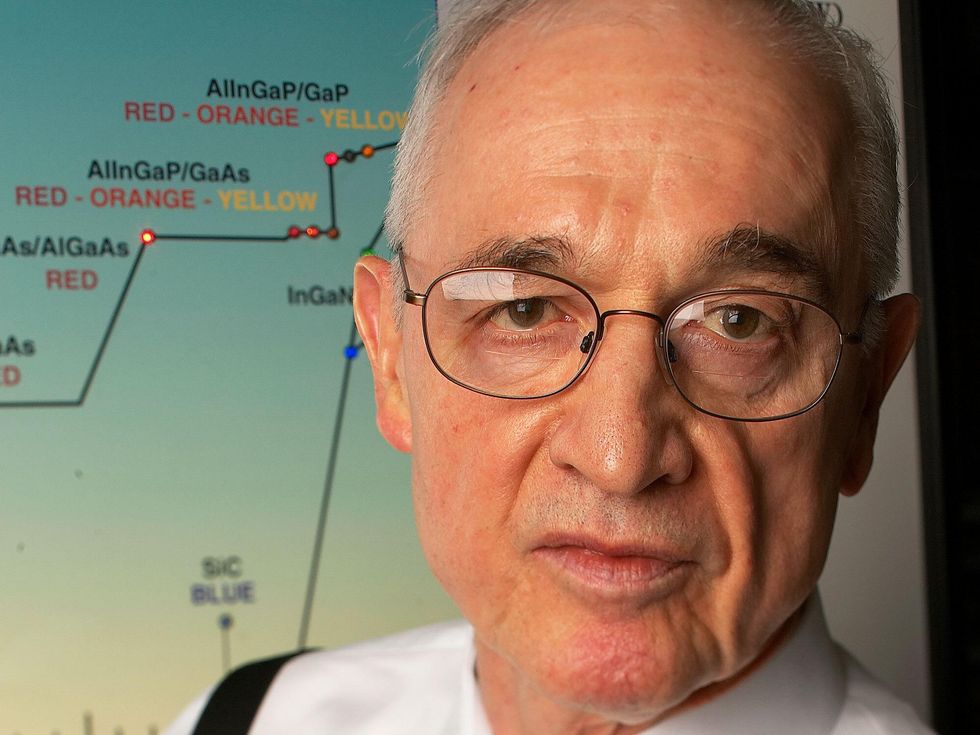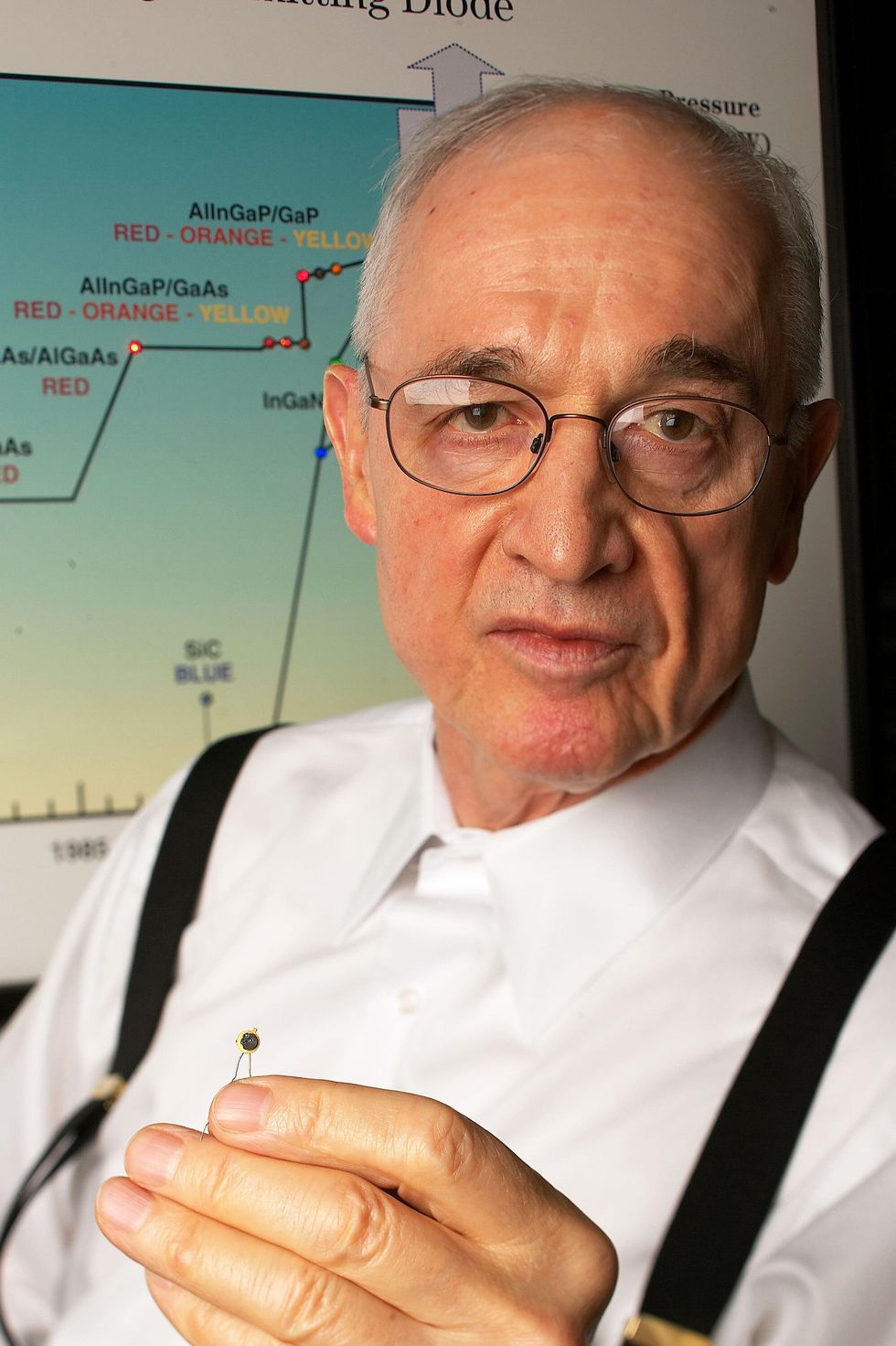
Remembering LED Pioneer Nick Holonyak


Nick Holonyak, Jr. retains a portion of a stoplight that utilizes a newer LED built by his college students. Ralf-Finn Hestoft/Getty Photographs
Nick Holonyak Jr., a prolific inventor and longtime professor of electrical engineering and computing, died on 17 September at the age of 93. In 1962, while working as a consulting scientist at Basic Electric’s State-of-the-art Semiconductor Laboratory, he invented the very first sensible obvious-spectrum LED. It is now utilized in gentle bulbs and lasers.
Holonyak still left GE in 1963 to grow to be a professor of electrical and personal computer engineering and researcher at his alma mater, the College of Illinois Urbana-Champaign. He retired from the college in 2013.
He received the 2003 IEEE Medal of Honor for “a career of groundbreaking contributions to semiconductors, such as the growth of semiconductor alloys and heterojunctions, and to noticeable mild-emitting diodes and injection lasers.”
LED and other semiconductor marketplace breakthroughs
Immediately after Holonyak acquired bachelor’s, master’s, and doctoral degrees in electrical engineering from the University of Illinois, he was hired in 1954 as a researcher at Bell Labs, in Murray Hill, N.J. There he investigated silicon-based electronic equipment.
He still left in 1955 to serve in the U.S. Military Sign Corps, and was stationed at Fort Monmouth, N.J., and Yokohama, Japan. Soon after currently being discharged in 1957, he joined GE’s Superior Semiconductor Laboratory, in Syracuse, N.Y.
Though at the lab, he invented a shorted emitter thyristor machine. The four-layered semiconductor is now discovered in light dimmers and electricity tools. In 1962 he invented the crimson-light semiconductor laser, recognised as a laser diode, which now is found in cellphones as effectively as CD and DVD gamers.
Later that yr, he shown the first noticeable LED—a semiconductor supply that emits light when present-day flows as a result of it. LEDs beforehand experienced been made of gallium arsenide. He established crystals of gallium arsenide phosphide to make LEDs that would emit visible, crimson gentle. His work led to the progress of the substantial-brightness, significant-efficiency white LEDs that are identified in a vast vary of purposes nowadays, like smartphones, televisions, headlights, website traffic signals, and aviation.
Pioneering research at the University of Illinois
Holonyak still left GE in 1963 and joined the College of Illinois as a professor of electrical and computer system engineering.
In 1977 he and his doctoral learners demonstrated the initial quantum well laser, which later on observed purposes in fiber optics, CD and DVD players, and health-related diagnostic tools.
The university named him an endowed-chair professor of electrical and pc engineering and physics in 1993. The placement was named for John Bardeen, an honorary IEEE member who had acquired two Nobel Prizes in Physics as effectively as the 1971 IEEE Medal of Honor. Bardeen was Holonyak’s professor in graduate college. The two adult males collaborated on research assignments until Bardeen’s death in 1991.
Jointly with IEEE Everyday living Fellow Milton Feng, Holonyak led the university’s transistor laser investigation center, which was funded by the U.S. Defense Sophisticated Investigate Projects Company. There they produced transistor lasers that had both gentle and electrical outputs. The innovation enabled substantial-speed communications systems.
Much more a short while ago, Holonyak created a strategy to bend light in just gallium arsenide chips, permitting them to transmit data by gentle somewhat than electric power.
He supervised extra than 60 graduate college students, a lot of of whom went on to come to be leaders in the electronics field.
Queen Elizabeth prize, Draper prize, and other awards
Holonyak been given final year’s Queen Elizabeth Prize for Engineering the National Academy of Engineering’s 2015 Draper Prize the 2005 Japan Prize and the 1989 IEEE Edison Medal. In 2008 he was inducted to the National Inventors Corridor of Fame, in Akron, Ohio.
He was a fellow of the American Academy of Arts and Sciences, the American Bodily Modern society, and Optica. He was also a overseas member of the Russian Academy of Sciences. In addition Holonyak was a member of the U.S. Academies of Engineering and Sciences.
Read through the comprehensive tale about Holonyak’s LED breakthrough in IEEE Spectrum.
